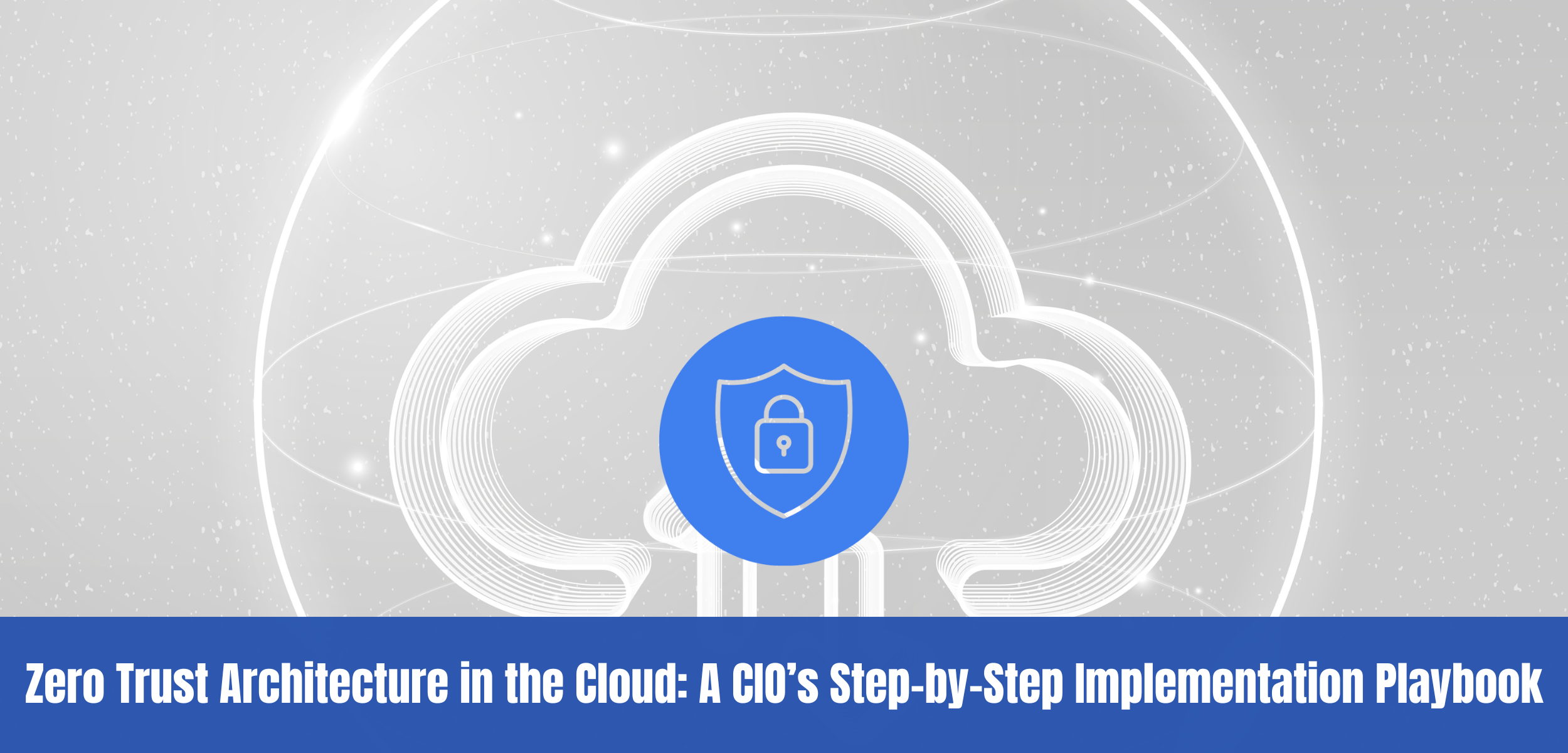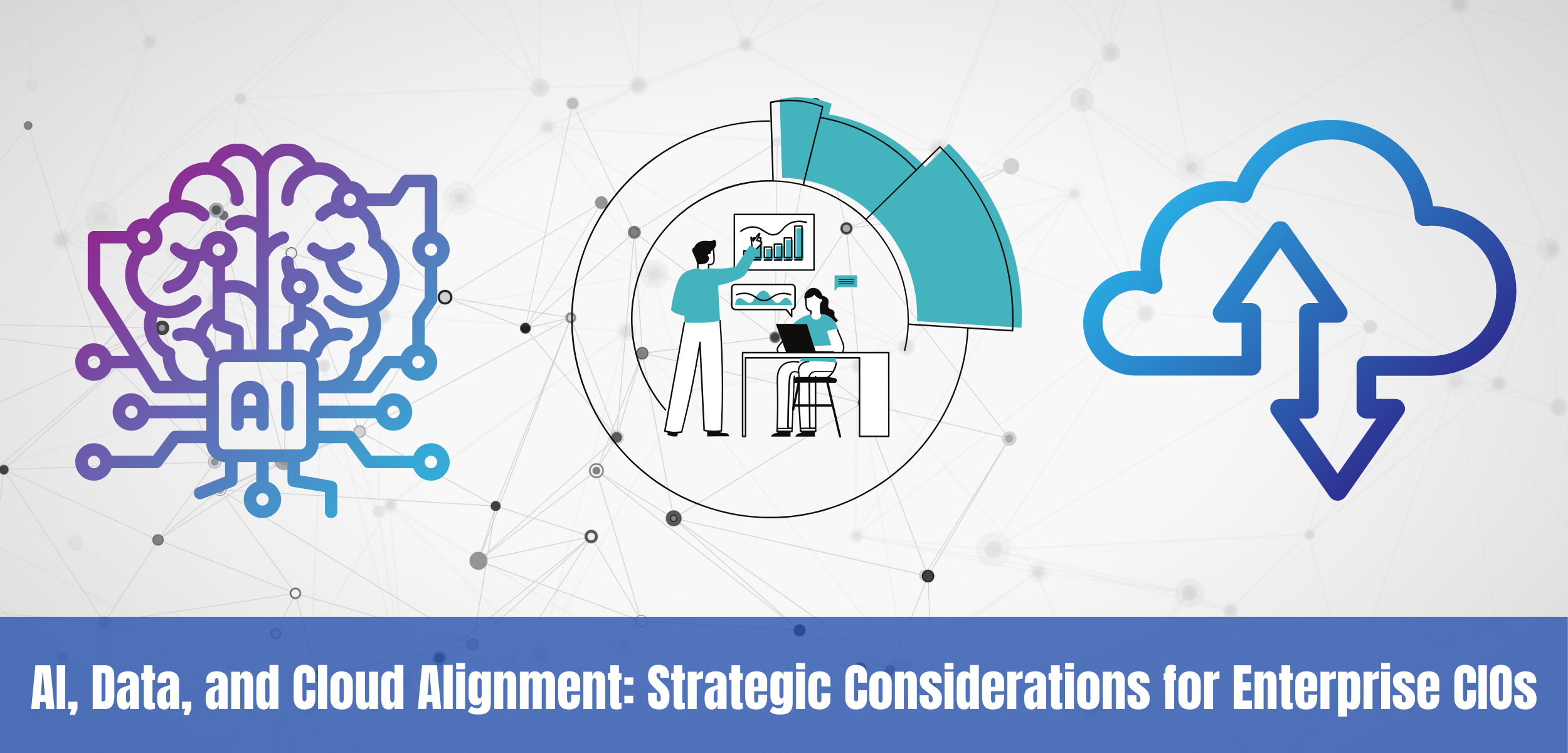As cloud adoption accelerates, enterprise security teams face an uncomfortable reality: the old perimeter is gone—and with it, the illusion of a trusted network. Hybrid workforces, multi-cloud strategies, and distributed digital ecosystems have rendered legacy security models obsolete. The resulting exposure has only intensified with rising insider threats, supply chain attacks, and identity breaches that easily bypass outdated controls.
In this environment, Zero Trust Architecture (ZTA) has emerged not as a buzzword, but as a foundational principle for securing digital infrastructure. For CIOs, it’s more than a technology investment—it’s a strategic imperative that must be carefully mapped across cloud, identity, network, and data layers.
This article offers a pragmatic, enterprise-scale implementation playbook for CIOs seeking to operationalize Zero Trust in the cloud—step by step, and with technical rigor.
1. Zero Trust in Context: Why Enterprises Can’t Wait

Today’s enterprise operates in an environment of constant risk and constant change. Employees access systems from personal devices, APIs connect dozens of third-party services, and cloud resources are spun up and torn down dynamically. The traditional model of defending a static perimeter has broken down entirely.
Regulators and cyber insurers now expect evidence of Zero Trust controls. Cloud breaches involving misconfigured access permissions or overly permissive roles are increasingly common. CIOs face pressure to reduce attack surfaces without slowing down innovation—a balance that only Zero Trust can realistically support.
2. Foundational Principles of Zero Trust Architecture
Zero Trust assumes breach. It removes implicit trust from every layer of the technology stack and enforces least-privilege access based on continuously validated context.
At its core, Zero Trust spans six key domains:
- Identity: Every user and service must prove who they are—continually.
- Devices: Endpoint posture and trustworthiness are validated before access.
- Networks: No traffic is trusted by default, internal or external.
- Applications & Workloads: Access is tightly scoped to function and context.
- Data: Access to sensitive data is governed by classification and behavior.
- Visibility & Analytics: Continuous monitoring drives real-time decisions.
|
Security Layer |
Legacy Model |
Zero Trust Model |
|
Network |
Internal trusted zone |
Micro-segmented, encrypted, verified |
|
Identity |
Static credentials |
Context-aware, adaptive access policies |
|
Device |
Minimal endpoint checks |
Continuous posture verification |
|
Application |
Broad access |
Role- and behavior-constrained access |
|
Data |
Flat access to storage |
Classification-driven, DLP-enabled |
3. Cloud-Native Threats that Zero Trust Mitigates
While the cloud offers agility and scale, it also introduces significant complexity:
- Dynamic infrastructure: VMs, containers, and serverless functions come and go rapidly.
- IAM sprawl: Misconfigured identity roles often lead to lateral movement and privilege escalation.
- Multi-cloud inconsistencies: Each provider has different tools and models, complicating uniform policy enforcement.
- Shadow IT: Departments procure SaaS tools without IT oversight, introducing unmanaged risk.
- API exposure: The expanding attack surface includes data-exposing APIs with weak access controls.
Zero Trust is uniquely suited to deal with this fluidity. It doesn’t rely on location or perimeter—it assumes all assets must be protected, no matter where they reside or how transient they are.
4. Designing a Cloud-Ready Zero Trust Architecture

Implementing ZTA in the cloud requires intentional design across multiple layers. Below are the core architectural elements that CIOs should plan for:
Identity and Access Management (IAM)- Centralize identity using SSO and federated directories (e.g., Azure AD, Google Workspace).
- Enforce multi-factor authentication (MFA) universally.
- Move toward Attribute-Based Access Control (ABAC) for policy flexibility.
- Audit and minimize standing privileges through Just-In-Time (JIT) access.
- Integrate Endpoint Detection and Response (EDR) for posture evaluation.
- Require device certificates and assess patch level and encryption status.
- Use identity signals from managed device platforms (e.g., Intune, Jamf).
Micro-Segmentation and Network Controls
- Apply software-defined perimeters (SDPs) to isolate applications and workloads.
- Restrict east-west traffic using cloud-native segmentation tools (e.g., AWS VPC Lattice, Azure Virtual Network).
- Utilize service meshes (e.g., Istio) to secure container-to-container communication.
Workload and Application Security
- Secure workloads with Cloud Workload Protection Platforms (CWPPs).
- Scan infrastructure-as-code templates for misconfigurations before deployment.
- Embed policies in CI/CD pipelines to enforce runtime security (e.g., admission control in Kubernetes).
- Classify data at the point of creation and enforce access via context.
- Apply encryption at rest and in transit using cloud-native KMS.
- Monitor data movement with Data Loss Prevention (DLP) tools.
- Deploy SIEM tools that ingest logs across identity, cloud, and network layers.
- Layer in User and Entity Behavior Analytics (UEBA) to detect anomalies.
- Automate response workflows with SOAR platforms for real-time enforcement.
5. CIO Playbook: From Strategy to Execution
Zero Trust adoption isn’t a product rollout—it’s a program. Here’s how CIOs can structure it.
Phase 1: Strategic Assessment
- Inventory cloud assets, user types, and access flows.
- Identify high-value applications and data that warrant early protection.
- Align ZTA goals with business objectives and compliance mandates.
Phase 2: Reference Architecture and Policy Design
- Choose between cloud-native tools and third-party integrations.
- Design policies using ABAC logic (e.g., “Allow access only if user is in HR, using a corporate device, during work hours”).
- Define enforcement points and telemetry collection for observability.
Phase 3: Controlled Implementation
- Begin with foundational capabilities: MFA, SSO, baseline network segmentation.
- Launch ZTA pilots in isolated domains (e.g., HR apps, finance systems).
- Collect data to refine policies before enterprise rollout.
Phase 4: Enterprise Rollout and Automation
- Automate provisioning and access enforcement using policy-as-code.
- Integrate with CI/CD and DevSecOps toolchains.
- Establish governance and review mechanisms to evolve with business change.
6. Cloud Platform Capabilities and Tooling Landscape
CIOs must understand both native cloud offerings and best-of-breed tools:
|
Function |
Cloud-Native Tools |
Third-Party Platforms |
|
Identity & SSO |
Azure AD, AWS IAM, Google Cloud IAM |
Okta, Ping Identity |
|
ZTNA & Access Enforcement |
Azure Private Link, BeyondCorp |
Zscaler, Cloudflare Zero Trust, Netskope |
|
Endpoint & Device Trust |
Defender for Endpoint, AWS Inspector |
CrowdStrike, SentinelOne |
|
Workload Protection |
Azure Defender, AWS GuardDuty |
Prisma Cloud, Wiz, Orca |
|
Monitoring & Analytics |
CloudTrail, Azure Sentinel, GCP Chronicle |
Splunk, Datadog, Elastic SIEM |
Decision-making should be based on integration maturity, operational overhead, and regulatory fit.
7. Governance, Risk, and Compliance Alignment
Zero Trust strengthens compliance posture but requires careful mapping:
- Align controls with ISO 27001, SOC 2, HIPAA, GDPR, and others.
- Use Cloud Security Posture Management (CSPM) tools for misconfiguration detection.
- Automate policy documentation and evidence collection for audit readiness.
Regular compliance reviews should be built into the governance lifecycle—not tacked on post-deployment.
8. Common Missteps and How to Avoid Them
- Over-engineering at the start
Zero Trust thrives in incremental implementation. Start with what you can measure and enforce confidently.
- Incomplete asset inventory
Without visibility into users, applications, and data flows, policy enforcement is ineffective.
- Treating ZTA as a security-only concern
Zero Trust must involve business leadership, legal, compliance, and operations to succeed.
The Road Ahead: AI-Augmented and Context-Driven Zero Trust
Zero Trust is evolving beyond static policies. The next generation will be powered by machine learning, risk scoring, and contextual adaptation.
- Policies will adjust dynamically based on behavior and telemetry.
- AI will help detect subtle identity compromise patterns in real time.
- Policy-as-code will unify development, security, and operations under a single control model.
CIOs should begin preparing for these shifts now—building architectures flexible enough to evolve.
Conclusion
Zero Trust is not an endpoint. It's a security posture that must evolve as threats and technologies change. For CIOs, it offers a sustainable path to reduce risk, improve visibility, and maintain control in an increasingly borderless enterprise.
The journey requires patience, architectural discipline, and cross-functional collaboration—but the payoff is a more resilient, responsive, and secure organization.
Need expert guidance to build your Zero Trust roadmap?
Connect with Evermethod Inc to architect scalable, cloud-native Zero Trust frameworks tailored to your enterprise.
Get the latest!
Get actionable strategies to empower your business and market domination
.png?width=882&height=158&name=882x158%20(1).png)

.png/preview.png?t=1721195409615)

%2013.png)


